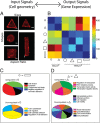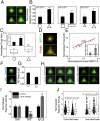Cell geometric constraints induce modular gene-expression patterns via redistribution of HDAC3 regulated by actomyosin contractility
- PMID: 23798429
- PMCID: PMC3710882
- DOI: 10.1073/pnas.1300801110
Cell geometric constraints induce modular gene-expression patterns via redistribution of HDAC3 regulated by actomyosin contractility
Abstract
Physical forces in the form of substrate rigidity or geometrical constraints have been shown to alter gene expression profile and differentiation programs. However, the underlying mechanism of gene regulation by these mechanical cues is largely unknown. In this work, we use micropatterned substrates to alter cellular geometry (shape, aspect ratio, and size) and study the nuclear mechanotransduction to regulate gene expression. Genome-wide transcriptome analysis revealed cell geometry-dependent alterations in actin-related gene expression. Increase in cell size reinforced expression of matrix-related genes, whereas reduced cell-substrate contact resulted in up-regulation of genes involved in cellular homeostasis. We also show that large-scale changes in gene-expression profile mapped onto differential modulation of nuclear morphology, actomyosin contractility and histone acetylation. Interestingly, cytoplasmic-to-nuclear redistribution of histone deacetylase 3 modulated histone acetylation in an actomyosin-dependent manner. In addition, we show that geometric constraints altered the nuclear fraction of myocardin-related transcription factor. These fractions exhibited hindered diffusion time scale within the nucleus, correlated with enhanced serum-response element promoter activity. Furthermore, nuclear accumulation of myocardin-related transcription factor also modulated NF-κB activity. Taken together, our work provides modularity in switching gene-expression patterns by cell geometric constraints via actomyosin contractility.
Keywords: MRTF-A signaling; cell matrix interaction; chromatin remodelling; substrate geometry; transcription control.
Conflict of interest statement
The authors declare no conflict of interest.
Figures







Similar articles
-
Compressive force induces reversible chromatin condensation and cell geometry-dependent transcriptional response.Mol Biol Cell. 2018 Dec 1;29(25):3039-3051. doi: 10.1091/mbc.E18-04-0256. Epub 2018 Sep 26. Mol Biol Cell. 2018. PMID: 30256731 Free PMC article.
-
Nuclear deformability and telomere dynamics are regulated by cell geometric constraints.Proc Natl Acad Sci U S A. 2016 Jan 5;113(1):E32-40. doi: 10.1073/pnas.1513189113. Epub 2015 Dec 22. Proc Natl Acad Sci U S A. 2016. PMID: 26699462 Free PMC article.
-
Regulation of nuclear architecture, mechanics, and nucleocytoplasmic shuttling of epigenetic factors by cell geometric constraints.Proc Natl Acad Sci U S A. 2019 Jul 2;116(27):13200-13209. doi: 10.1073/pnas.1902035116. Epub 2019 Jun 17. Proc Natl Acad Sci U S A. 2019. PMID: 31209017 Free PMC article.
-
Redox regulation of histone deacetylases and glucocorticoid-mediated inhibition of the inflammatory response.Antioxid Redox Signal. 2005 Jan-Feb;7(1-2):144-52. doi: 10.1089/ars.2005.7.144. Antioxid Redox Signal. 2005. PMID: 15650403 Review.
-
Nuclear matrix, dynamic histone acetylation and transcriptionally active chromatin.Mol Biol Rep. 1997 Aug;24(3):197-207. doi: 10.1023/a:1006811817247. Mol Biol Rep. 1997. PMID: 9291093 Review.
Cited by
-
Nectin-4 regulates cellular senescence-associated enlargement of cell size.Sci Rep. 2023 Dec 7;13(1):21602. doi: 10.1038/s41598-023-48890-z. Sci Rep. 2023. PMID: 38062106 Free PMC article.
-
Cell Behavioral Dynamics as a Cue in Optimizing Culture Stabilization in the Bioprocessing of Pluripotent Stem Cells.Bioengineering (Basel). 2022 Nov 9;9(11):669. doi: 10.3390/bioengineering9110669. Bioengineering (Basel). 2022. PMID: 36354580 Free PMC article. Review.
-
Viscoelasticity, Like Forces, Plays a Role in Mechanotransduction.Front Cell Dev Biol. 2022 Feb 9;10:789841. doi: 10.3389/fcell.2022.789841. eCollection 2022. Front Cell Dev Biol. 2022. PMID: 35223831 Free PMC article. Review.
-
Extracellular Adhesive Cues Physically Define Nucleolar Structure and Function.Adv Sci (Weinh). 2022 Apr;9(10):e2105545. doi: 10.1002/advs.202105545. Epub 2022 Feb 5. Adv Sci (Weinh). 2022. PMID: 35122409 Free PMC article.
-
A Src-H3 acetylation signaling axis integrates macrophage mechanosensation with inflammatory response.Biomaterials. 2021 Dec;279:121236. doi: 10.1016/j.biomaterials.2021.121236. Epub 2021 Oct 29. Biomaterials. 2021. PMID: 34753038 Free PMC article.
References
-
- Jean RP, Gray DS, Spector AA, Chen CS. Characterization of the nuclear deformation caused by changes in endothelial cell shape. J Biomech Eng. 2004;126(5):552–558. - PubMed
-
- Versaevel M, Grevesse T, Gabriele S. Spatial coordination between cell and nuclear shape within micropatterned endothelial cells. Nat Commun. 2012;3:671. - PubMed
-
- Théry M, Pépin A, Dressaire E, Chen Y, Bornens M. Cell distribution of stress fibres in response to the geometry of the adhesive environment. Cell Motil Cytoskeleton. 2006;63(6):341–355. - PubMed
-
- Vergani L, Grattarola M, Nicolini C. Modifications of chromatin structure and gene expression following induced alterations of cellular shape. Int J Biochem Cell Biol. 2004;36(8):1447–1461. - PubMed
Publication types
MeSH terms
Substances
LinkOut - more resources
Full Text Sources
Other Literature Sources
Molecular Biology Databases

